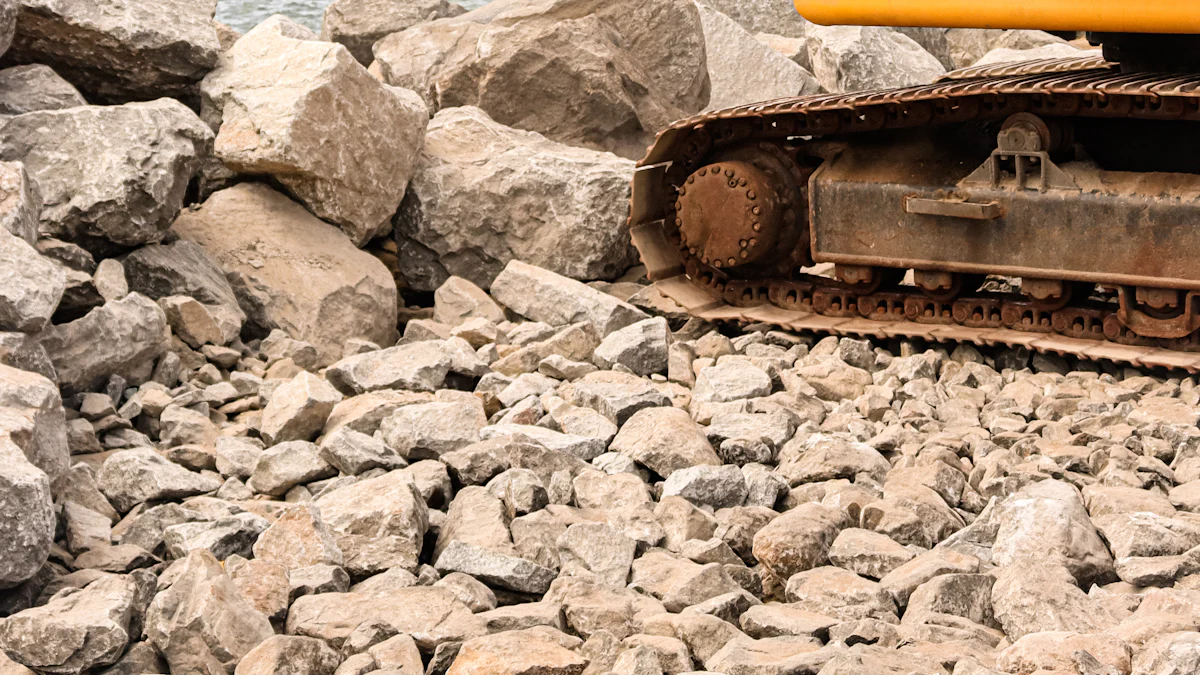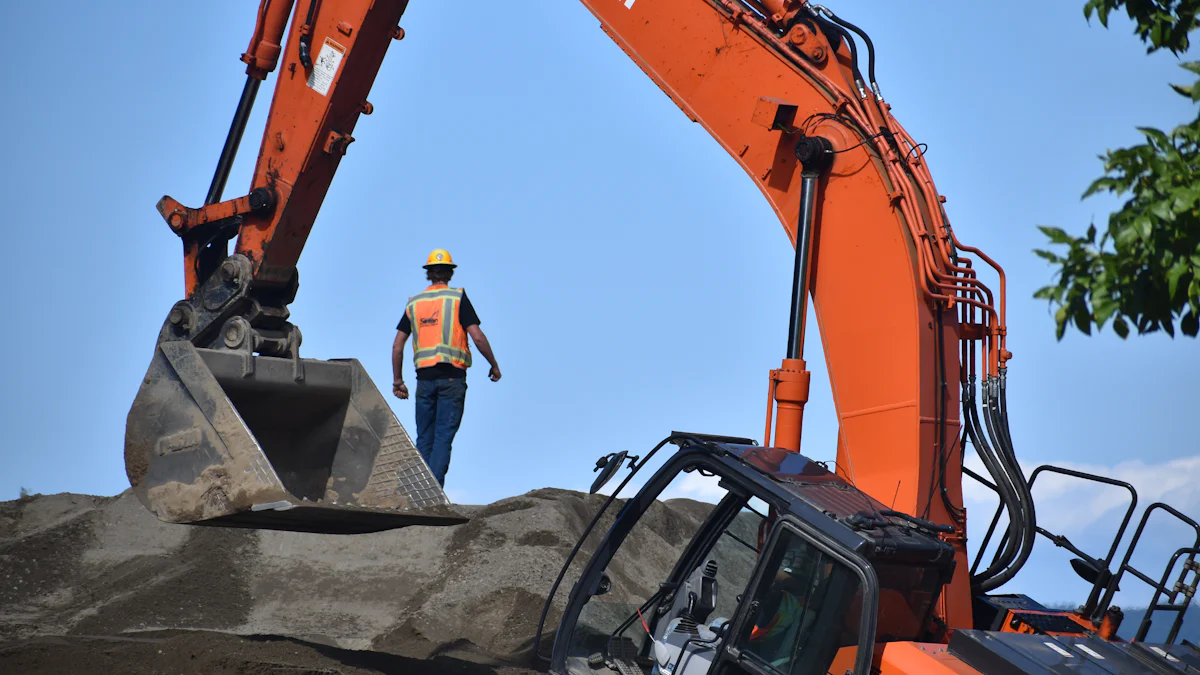
The excavator cabin serves as your command center, designed to prioritize your comfort, safety, and efficiency. Every detail inside reflects a focus on enhancing your experience. From ergonomic seating that supports long hours of operation to strategically placed controls, the cabin ensures you can work with precision and ease. Modern advancements, like air conditioning and adaptive displays, further elevate your productivity. This enclosed space not only shields you from external elements but also provides a quieter, healthier environment, allowing you to focus entirely on managing the excavator inside.
Key Takeaways
The excavator cabin is designed as a command center, prioritizing operator comfort, safety, and efficiency.
Ergonomic seating with adjustable features minimizes fatigue, allowing operators to work longer hours comfortably.
Strategically placed controls and large glass panels enhance visibility and accessibility, reducing blind spots and improving operational precision.
Modern excavators include advanced technology in control panels, such as touchscreens and operator assistance systems, to boost productivity and safety.
Climate control systems maintain a comfortable working environment, which is crucial for operator performance in varying weather conditions.
Built-in safety features, like Rollover Protection Structures (ROPS) and proximity sensors, ensure a secure workspace and reduce accident risks.
Regular maintenance and high-quality components are essential for maximizing the efficiency and longevity of the excavator cabin.
The Operator’s Seat: The Heart of the Excavator Inside

Ergonomic Design for Operator Comfort
The operator’s seat is the centerpiece of the excavator cabin. It is meticulously designed to provide maximum comfort during long hours of operation. Modern seats feature ergonomic contours that support your posture and reduce fatigue. Adjustable settings allow you to customize the seat height, backrest angle, and armrest position, ensuring a perfect fit for your body. This adaptability minimizes strain on your muscles and joints, enabling you to focus entirely on the task at hand.
Manufacturers have integrated advanced materials into seat construction to enhance durability and comfort. Many seats now include suspension systems that absorb vibrations from the machine, creating a smoother experience even on rough terrains. These features not only improve your physical well-being but also boost productivity by keeping you comfortable and alert throughout the workday.
Strategic Placement for Maximum Visibility and Accessibility
The placement of the operator’s seat plays a crucial role in ensuring efficiency and safety. Positioned at the center of the cabin, the seat provides you with an optimal view of the excavator inside and its surroundings. This strategic location minimizes blind spots, allowing you to operate the machine with precision and confidence.
Modern excavators often include large glass panels around the cabin to further enhance visibility. These panels reduce obstructions and give you a clear line of sight to the work area. Some models even incorporate UV-protective tints on windows, shielding you from harmful sun exposure while maintaining a cool interior environment.
In addition to visibility, the seat’s placement ensures easy access to all controls and instruments. Whether you’re operating joysticks, pedals, or monitors, everything is within arm’s reach. This thoughtful design reduces unnecessary movements, helping you maintain focus and efficiency. By combining comfort, visibility, and accessibility, the operator’s seat truly becomes the heart of the excavator cabin.
Control Panels: The Brain of the Cabin
The control panels in an excavator cabin serve as the central hub for managing the machine’s operations. These panels house the essential tools you need to operate the excavator inside efficiently and safely. By understanding the layout and purpose of these controls, you can maximize productivity and ensure smooth operation.
Essential Controls and Indicators
The control panels include a variety of components that allow you to manage the excavator’s movements and functions. These components of the cab are strategically arranged to provide easy access and intuitive operation. Key controls include:
Joysticks and levers: These manage the boom, arm, and bucket movements. They allow you to perform precise digging, lifting, and positioning tasks.
Pedals and foot controls: These control the excavator’s travel and swing functions, enabling smooth navigation and rotation.
Switches and buttons: These activate auxiliary functions, such as lights, wipers, or additional attachments.
Indicators on the control panel provide real-time feedback about the machine’s status. You can monitor fuel levels, engine temperature, and hydraulic pressure through these displays. This information helps you identify potential issues early, ensuring the excavator operates at peak performance.
Advanced Features in Modern Excavators
Modern excavators incorporate advanced technology into their control panels, enhancing both functionality and ease of use. Touchscreen monitors and liquid crystal displays (LCDs) have become standard features in many models. These screens allow you to access detailed information about the excavator inside, including performance metrics and diagnostic data.
One of the most innovative advancements is the ability to store preset configurations for hydraulic attachments. You can select the appropriate settings for different tools, such as hydraulic breakers or tilting buckets, directly from the monitor. This feature optimizes the excavator’s performance and reduces the time spent on manual adjustments.
Some control panels also include operator assistance systems. These systems provide visual and auditory alerts to improve safety and precision. For example, cameras integrated into the cabin offer a clear view of blind spots, while proximity sensors warn you of obstacles in the work area.
By familiarizing yourself with the cab components and their functionalities, you can take full advantage of these advanced features. The control panels truly represent the brain of the cabin, empowering you to operate the excavator with confidence and efficiency.
Joysticks and Levers: Precision Tools for Excavator Inside Operations

Primary Functions of Joysticks
Joysticks serve as your primary interface for controlling the excavator inside. These precision tools allow you to manage the boom, arm, and bucket with ease. By simply moving the joysticks in specific directions, you can perform complex tasks like digging, lifting, and dumping. This intuitive design ensures that even operators with minimal experience can quickly adapt to the controls.
Unlike traditional mechanical levers, joysticks require less physical effort. This low-effort operation reduces fatigue, enabling you to work for extended hours without discomfort. The ergonomic design of modern joysticks further enhances your experience by providing a comfortable grip and smooth movement. These features make joysticks an essential part of the cabin, ensuring both efficiency and operator well-being.
Enhancing Precision and Responsiveness
Joysticks excel in delivering precise control and responsiveness. They offer a direct hand-to-power ratio, allowing you to anticipate and execute movements with accuracy. This level of control inspires confidence, especially when performing delicate tasks like trenching or grading. The responsiveness of joysticks ensures that every input translates into immediate action, giving you full command over the excavator’s operations.
Modern joysticks also integrate advanced technology to enhance productivity. For instance, some models include programmable buttons that let you customize functions for specific tasks. This feature streamlines your workflow by reducing the need for manual adjustments. Additionally, joysticks often work in tandem with other cab components and their functionalities, such as monitors and sensors, to provide real-time feedback and improve operational efficiency.
By replacing traditional levers, joysticks have transformed parts of an excavator into a more operator-friendly system. They not only simplify the learning curve for new operators but also attract younger talent to the industry. This shift towards joystick controls reflects a broader trend in modern excavator design, prioritizing comfort, precision, and ease of use.
Pedals and Foot Controls: Navigating the Excavator Cabin
Pedals and foot controls play a vital role in managing the excavator inside. These components allow you to control essential movements and functions with precision. By mastering their use, you can navigate the machine efficiently and enhance your productivity.
Travel and Swing Pedals
Travel and swing pedals are fundamental parts of an excavator. They enable you to move the machine and rotate its upper structure. The travel pedals control the forward and backward movement of the excavator. By pressing the left or right pedal, you can steer the machine in the desired direction. This straightforward mechanism ensures smooth navigation, even in confined spaces.
The swing pedals, on the other hand, manage the 360-degree rotation of the excavator’s upper body. This feature allows you to position the bucket accurately without repositioning the entire machine. For example, when working in a tight area, you can rotate the cabin and arm to access different spots without moving the undercarriage. This capability not only saves time but also reduces wear on the tracks, enhancing the machine’s longevity.
Did you know? The swing gear, a critical component connected to the swing pedals, enables this seamless rotation. It ensures that the excavator can work within a wide radius, boosting both versatility and efficiency.
Auxiliary Foot Controls for Attachments
Auxiliary foot controls provide additional functionality for operating attachments. These controls allow you to manage tools like hydraulic breakers, grapples, or augers with ease. By pressing the auxiliary pedals, you can activate or adjust the attachment’s movements, ensuring precise operation.
For instance, when using a hydraulic breaker, the auxiliary foot controls let you regulate the force and frequency of the tool. This level of control is essential for tasks that require accuracy, such as breaking concrete or compacting soil. These pedals also simplify the process of switching between attachments, making your workflow more efficient.
Modern excavators often include customizable settings for auxiliary controls. You can program the pedals to suit specific tasks, reducing the need for manual adjustments. This adaptability enhances your ability to handle diverse projects, from digging trenches to demolishing structures.
By understanding and utilizing the pedals and foot controls effectively, you can unlock the full potential of the excavator inside. These components are designed to make your work smoother, safer, and more productive.
Monitors and Displays: Real-Time Insights Inside the Cabin
Modern excavator cabins feature advanced monitors and displays that provide you with real-time insights into the machine’s performance and surroundings. These tools are essential for maintaining efficiency, ensuring safety, and simplifying operations. By understanding the capabilities of these monitors, you can make informed decisions and optimize your workflow.
Machine Performance and Diagnostics
Monitors in the cabin act as your window into the excavator’s vital statistics. They display critical information such as engine coolant temperature, fuel levels, hydraulic fluid levels, and throttle position. This data helps you track the machine’s performance and identify potential issues before they escalate. For example, monitoring hydraulic fluid levels ensures smooth operation and prevents costly downtime.
Many modern excavators use LCD monitors that replace traditional gauges. These screens offer improved visibility and functionality, allowing you to access detailed diagnostic information with ease. You can view pressure readings, filter conditions, and even stored anomalies for troubleshooting. This level of insight simplifies maintenance and ensures the excavator operates at peak efficiency.
Pro Tip: Regularly check the monitor for alerts or warnings. Addressing these promptly can extend the life of your excavator and reduce repair costs.
Enhancing Safety with Camera Feeds and Alerts
Safety is a top priority in any work environment, and the monitors in your cabin play a crucial role in ensuring it. Many excavators now include integrated camera systems that provide live feeds of the surrounding area. These cameras help you eliminate blind spots, making it easier to navigate tight spaces and avoid obstacles.
In addition to cameras, monitors often display proximity alerts and other safety notifications. For instance, sensors can detect nearby objects and issue visual or auditory warnings. These features enhance your situational awareness and reduce the risk of accidents.
Some advanced systems even allow you to customize safety settings. You can adjust the sensitivity of proximity sensors or configure alerts to suit specific job requirements. This adaptability ensures that the safety features align with your unique needs, providing an extra layer of protection.
By leveraging the capabilities of monitors and displays, you can stay informed, work efficiently, and maintain a safe operating environment. These tools transform the cabin into a high-tech command center, empowering you to tackle any task with confidence.
Climate Control and Comfort Features in the Excavator Cabin
Temperature Regulation for All-Weather Operation
The excavator cabin ensures you stay comfortable regardless of the weather. Modern cabins include advanced climate control systems that regulate temperature effectively. These systems allow you to adjust the heating or cooling settings to match the external conditions. Whether you are working in freezing winters or scorching summers, the cabin maintains a consistent and comfortable environment.
Air conditioning units in the cabin provide cool air during hot days, preventing heat exhaustion. Heating systems, on the other hand, keep you warm in cold climates, ensuring you remain focused on your tasks. Some cabins also feature automatic climate control, which adjusts the temperature based on sensors that detect the cabin’s internal conditions. This feature eliminates the need for constant manual adjustments, letting you concentrate on operating the machine.
Scientific Research Findings: Studies have shown that maintaining a stable temperature inside enclosed cabs can improve operator performance and reduce fatigue. Proper temperature regulation also minimizes the risk of health issues caused by extreme weather conditions.
By keeping the cabin’s temperature comfortable, you can work efficiently and safely, no matter the environment.
Noise and Vibration Reduction for Operator Well-Being
Noise and vibration reduction play a crucial role in enhancing your well-being inside the excavator cabin. Manufacturers design modern cabins with insulation materials that block external noise. This feature creates a quieter workspace, allowing you to focus on operating the machine without distractions. Reduced noise levels also protect your hearing, especially during long hours of operation.
Vibration-dampening technology further improves your experience. Seats with built-in suspension systems absorb vibrations caused by the excavator’s movements. This reduces the strain on your body, particularly your back and joints. Additionally, the cabin’s structure often includes vibration-isolating mounts, which minimize the transfer of vibrations from the machine to the operator.
Did you know? Enclosed cabs with proper design considerations not only enhance comfort but also protect operators from harmful contaminants like dust. This added protection contributes to a healthier working environment.
By reducing noise and vibrations, the cabin ensures you remain comfortable and alert throughout your workday. These features not only improve your physical health but also enhance your overall productivity.
Safety Features Inside the Excavator Cabin
Built-In Protective Measures
The excavator cabin incorporates several built-in safety features to protect you during operation. One of the most critical components is the Rollover Protection Structure (ROPS). This sturdy frame surrounds the cabin, shielding you from potential injuries in the event of a rollover. The ROPS ensures that the cabin remains intact, providing a secure space even in challenging situations.
Another essential feature is the counterweight located at the rear of the excavator. This counterweight enhances stability by balancing the machine during lifting and digging tasks. It prevents tipping, especially when handling heavy loads or operating on uneven terrain. By maintaining balance, the counterweight ensures your safety and the machine’s efficiency.
Visibility also plays a vital role in safety. Modern excavator cabins feature large glass panels and strategically placed mirrors to minimize blind spots. These design elements give you a clear view of your surroundings, reducing the risk of accidents. Some models even include UV-protective tints on windows, which not only shield you from harmful rays but also improve visibility in bright conditions.
Hydraulic fluid tanks are securely housed within the cabin to prevent leaks or damage. This placement reduces the risk of hazardous spills, ensuring a safer working environment. Additionally, safety lock levers are integrated into the cabin to prevent unintended movements when the machine is idle. Engaging these levers adds an extra layer of protection, keeping you and those around you safe.
Operator Assistance Systems for Enhanced Safety
Modern excavators come equipped with advanced operator assistance systems that elevate safety standards. These systems include monitors and control panels that display real-time information about the machine’s status. You can monitor fuel levels, hydraulic pressure, and error codes directly from the cabin. Addressing these alerts promptly helps you avoid potential issues and maintain smooth operations.
Integrated camera systems provide live feeds of the excavator’s surroundings. These cameras eliminate blind spots, allowing you to navigate tight spaces with confidence. Proximity sensors further enhance safety by detecting nearby obstacles and issuing warnings. These alerts help you avoid collisions, ensuring a safer work environment.
Some excavators also feature customizable safety settings. You can adjust the sensitivity of sensors or configure alerts to suit specific job requirements. This adaptability ensures that the safety systems align with your needs, providing tailored protection.
Quick Tip: Always check the safety lock lever and monitor for error codes before starting the machine. These simple steps can prevent accidents and extend the life of your excavator.
By combining built-in protective measures with advanced operator assistance systems, the excavator cabin becomes a secure and efficient workspace. These features not only safeguard you but also enhance your confidence and productivity during operation.
YNF Machinery: Your Partner for Excavator Cabin Components
High-Quality Parts for Excavator Inside Operations
When it comes to maintaining the efficiency and reliability of your excavator, the quality of its components plays a crucial role. At YNF Machinery, we specialize in providing top-tier parts that ensure your excavator cabin operates seamlessly. From ergonomic seats to advanced control panels, we offer a wide range of components designed to enhance your machine’s performance.
Our inventory includes some of the key parts of an excavator, such as joysticks, pedals, and monitors. These components are essential for precise operations and smooth functionality. For example, our joysticks provide exceptional responsiveness, allowing you to control the boom, arm, and bucket with ease. Similarly, our monitors deliver real-time insights into machine diagnostics, helping you maintain peak performance.
We understand that the main parts of an excavator must withstand demanding conditions. That’s why every product we supply undergoes rigorous quality checks. This ensures durability and reliability, even in the toughest environments. Whether you need replacement parts or upgrades, YNF Machinery guarantees components that meet the highest standards.
Did you know? The cabin is one of the most critical parts of an excavator. It houses the operator and vital systems that control the machine’s functions. Ensuring the quality of cabin components directly impacts safety, comfort, and productivity.
Supporting Operator Comfort and Efficiency with Reliable Components
Operator comfort and efficiency are at the heart of modern excavator design. YNF Machinery supports these priorities by offering components that enhance the working environment inside the cabin. Our products, such as vibration-dampening seats and climate control systems, are engineered to reduce fatigue and improve focus during long hours of operation.
For instance, our seats feature advanced suspension systems that absorb vibrations, ensuring a smoother experience on rough terrains. Additionally, our climate control solutions maintain a comfortable temperature inside the cabin, regardless of external weather conditions. These features not only improve operator well-being but also boost overall productivity.
Safety is another area where we excel. Our components, like ROPS-compliant structures and proximity sensors, provide an added layer of protection. These features minimize risks and create a secure workspace for operators. By prioritizing safety and comfort, YNF Machinery helps you get the most out of your excavator.
Quick Tip: Regular maintenance of the cabin and its components can extend the life of your excavator. Replacing worn-out parts promptly ensures uninterrupted operations and reduces downtime.
At YNF Machinery, we are committed to supporting your success. Our high-quality components for the cabin and other parts of an excavator are designed to meet your specific needs. With over 35 years of experience, we have built a reputation for reliability and excellence. Trust us to be your partner in keeping your excavator running smoothly.
The excavator cabin stands as a well-designed space that prioritizes your comfort, safety, and efficiency. Its thoughtful layout ensures that every component works seamlessly to enhance your performance. By understanding the anatomy of an excavator, you gain valuable insights into how these elements contribute to smooth and safe operations. At YNF Machinery, we provide high-quality parts to keep your cabin functioning at its best. With our reliable components, you can maintain optimal performance and create a productive working environment.





